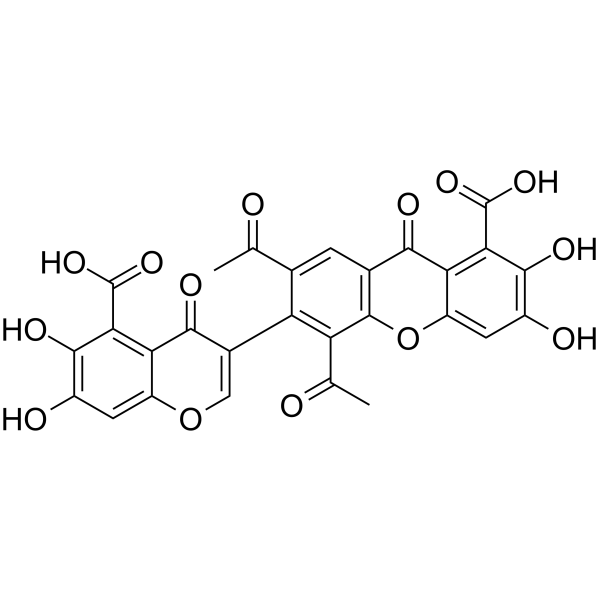Vinaxanthone |
| Catalog No.GC72076 |
Vinaxanthone(SM - 345431) est un inhibiteur puissant et sélectif de la signaline 3a, de la Phospholipase C (PLC) et de la Fabi, avec des IC50 de 0,1 à 0,2 µm et 0,9 mm respectivement pour la signaline 3A et la Fabi.
Products are for research use only. Not for human use. We do not sell to patients.

Cas No.: 133293-89-7
Sample solution is provided at 25 µL, 10mM.
Vinaxanthone shows selective inhibitory activity against phospholipase C (PLC) from rat brain, mutine colon 26 Adenocarcinoma and murine fibroblasts NIH3T3 with IC50s being 5.4, 9.3 and 44 μM, respectively[1].
Vinaxanthone (0.1 mg/mL, 24 h) enhances peripheral nerve regeneration and induces small amounts of neovascularization growth into the cornea[4].
Vinaxanthone (0.5 μM, 20 min) may protects from Dox-induced podocyte apoptosis[5].
Vinaxanthone (0.1-1 μM, 24 h) ameliorates the TGF-β1-induced tubular cell characteristic change[6].
Vinaxanthone (SM-345431) (0.1 mg/mL, Subconjunctival injections, every 2 days, 3 weeks) accelerates peripheral nerve regeneration and sensitivity in a murine corneal transplantation model[4].
Vinaxanthone (SEMA3A-I) (20 µg, i.p.) protects from Doxorubicin -induced podocyte injury through an anti-apoptosis mechanism in mouse model of Doxorubicin -induced podocytopathy[5].
References:
[1]. Masahiro Aoki, et al. Structure of a novel phospholipase C inhibitor, vinaxanthone (Ro 09-1450), produced by penicillium vinaceum. Tetrahedron Letters. 1991, 32 (36):4737-4740.
[2]. Liang Zhang, et al. Rewiring of regenerated axons by combining treadmill training with semaphorin3A inhibition. Mol Brain. 2014 Mar 10; 7:14.
[3]. Zheng CJ, et al. Vinaxanthone, a new FabI inhibitor from Penicillium sp. J Antimicrob Chemother. 2009 May;63(5):949-53.
[4]. Omoto M, Yoshida S, Miyashita H, Kawakita T, Yoshida K, Kishino A, Kimura T, Shibata S, Tsubota K, Okano H, Shimmura S. The semaphorin 3A inhibitor SM-345431 accelerates peripheral nerve regeneration and sensitivity in a murine corneal transplantation model. PLoS One. 2012;7(11):e47716.
[5]. Sang Y, et al. Semaphorin3A-Inhibitor Ameliorates Doxorubicin-Induced Podocyte Injury. Int J Mol Sci. 2020 Jun 8;21(11):4099.
[6]. Sang Y, et al. Semaporin3A inhibitor ameliorates renal fibrosis through the regulation of JNK signaling. Am J Physiol Renal Physiol. 2021 Dec 1;321(6):F740-F756.
Average Rating: 5 (Based on Reviews and 30 reference(s) in Google Scholar.)
GLPBIO products are for RESEARCH USE ONLY. Please make sure your review or question is research based.
Required fields are marked with *




















